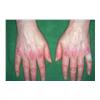 Cold temperatures or strong emotions in people with Raynaud’s phenomenon (disease) result in blood vessel spasms (attacks), which block blood flow to the fingers, toes, ears, and nose.
Cold temperatures or strong emotions in people with Raynaud’s phenomenon (disease) result in blood vessel spasms (attacks), which block blood flow to the fingers, toes, ears, and nose.
Researchers at Radboud University Nijmegen Medical Centre, in the Netherlands explored the possible beneficial effects and tolerability of Ginkgo biloba special extract EGb 761. Continue reading Ginkgo biloba extract EGb 761 to treat Raynaud’s →
 People with Raynaud’s disease experience cold and pain in their fingers, toes, nose, and ears when exposed to temperature changes or stress.
People with Raynaud’s disease experience cold and pain in their fingers, toes, nose, and ears when exposed to temperature changes or stress.
The World Health Organization recommends using ginkgo to treat Raynaud’s disease.
Actually, the scientific support for this recommendation is minimal –- just one positive study published in 2003. Continue reading Using ginkgo biloba to treat Raynaud’s disease →
 Raynaud’s disease causes some areas of the body (fingers, toes, tip of the nose and ears) to feel numb and cool in response to cold temperatures or stress. During a Raynaud’s attack, the arteries become narrow and limit blood flow to affected areas.
Raynaud’s disease causes some areas of the body (fingers, toes, tip of the nose and ears) to feel numb and cool in response to cold temperatures or stress. During a Raynaud’s attack, the arteries become narrow and limit blood flow to affected areas.
During the American Academy of Family Physicians 2007 Annual Scientific Assembly Ginkgo biloba was reportedly less effective than the calcium channel blocker nifedipine (Adalat, Procardia). Continue reading Ginkgo biloba vs nifedipine to treat Raynaud’s disease →
 Garlic (Allium sativum) is one of the most commonly used supplements.
Garlic (Allium sativum) is one of the most commonly used supplements.
But based on the results of this review by Professor Ernst at the Universities of Exeter and Plymouth in the UK, it’s most useful to simply season food. Continue reading Garlic: What’s it good for? →
 The aims of balneotherapy (treatment of disease by bathing) are to soothe the pain, improve joint motion, and as a consequence, relieve people’s suffering and make them feel well.
The aims of balneotherapy (treatment of disease by bathing) are to soothe the pain, improve joint motion, and as a consequence, relieve people’s suffering and make them feel well.
Although most studies report positive outcomes, the trials are so poorly designed that “positive findings” should be viewed with caution, according to the Cochrane Collaboration, which included studies up to 2002.
What’s happened since?
Continue reading Balneotherapy for patients with arthritis →
Complementary and Alternative Medicine: Fair, Balanced, and to the Point
 Cold temperatures or strong emotions in people with Raynaud’s phenomenon (disease) result in blood vessel spasms (attacks), which block blood flow to the fingers, toes, ears, and nose.
Cold temperatures or strong emotions in people with Raynaud’s phenomenon (disease) result in blood vessel spasms (attacks), which block blood flow to the fingers, toes, ears, and nose. People with Raynaud’s disease experience cold and pain in their fingers, toes, nose, and ears when exposed to temperature changes or stress.
People with Raynaud’s disease experience cold and pain in their fingers, toes, nose, and ears when exposed to temperature changes or stress. Garlic (Allium sativum) is one of the most commonly used
Garlic (Allium sativum) is one of the most commonly used  The aims of balneotherapy (treatment of disease by bathing) are to soothe the pain, improve joint motion, and as a consequence, relieve people’s suffering and make them feel well.
The aims of balneotherapy (treatment of disease by bathing) are to soothe the pain, improve joint motion, and as a consequence, relieve people’s suffering and make them feel well.